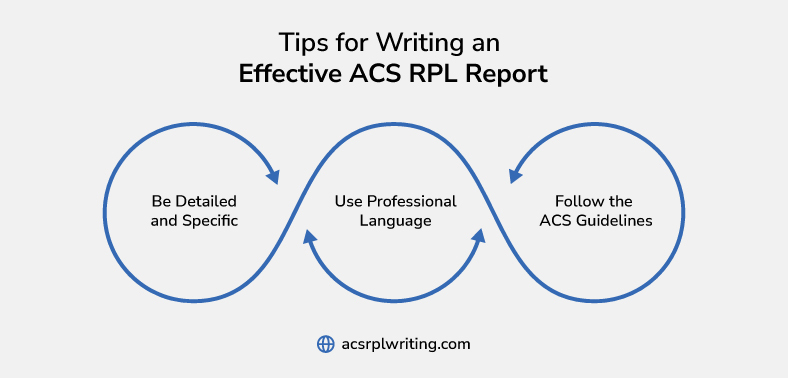
Crafting an Effective ACS RPL Report for Skilled Migration
RPL is a report that is written and submitted to the Australian Computer Society (ACS). You write RPL report when you want to go to Australia with your career in ICT-related fields but you don’t have a degree in it. The report helps ACS decide if they’re good enough for the job they want in the IT industry.
The Australian Computer Society (ACS) Recognition of Prior Learning (RPL) report is a crucial component for ICT professionals seeking skilled migration to Australia. This comprehensive guide will provide detailed insights into the process of writing an effective ACS RPL report, covering each aspect thoroughly.
1. Understanding the ACS RPL report
1.1 What is an ACS RPL report?
An ACS RPL report is a document that assesses the ICT skills and qualifications of applicants who do not hold a recognized ICT qualification but have relevant work experience.
Your RPL project report should solely reflect your own efforts and showcase your extensive ICT knowledge. Ensure to provide ample detail to demonstrate your expertise and appropriately cite any quoted or paraphrased content as well as all sources referenced in the report.
2. Eligibility criteria
2.1 Who is eligible for an ACS RPL report?
ICT professionals with non-ICT qualifications or insufficient ICT qualifications but who possess relevant work experience are eligible.
Applicants must demonstrate their ICT knowledge and skills through the RPL report.
3. Components of an ACS RPL report
3.1 Career Episodes
- Provide detailed descriptions of specific projects or tasks undertaken in the ICT domain.
- Each episode should focus on different aspects of ICT competency, such as problem-solving, technical skills, and project management.
3.2 Summary Statement
- Links each career episode to the relevant ICT competencies as per the ACS guidelines.
- Demonstrates how the applicant meets the required standards for ICT competency.
Learn More: Documents needed for ACS RPL report. 📃📃👈👈
4. Writing the ACS RPL report
4.1 Understanding the ACS Key Areas of Knowledge
- Familiarize yourself with the ACS Key Areas of Knowledge (KAoK) relevant to your ICT field.
- Align your career episodes and summary statement with the KAoK to demonstrate your ICT proficiency.
4.2 Structuring your Career Episodes
- Provide detailed descriptions of your roles, responsibilities, and achievements in each episode.
- Use clear and concise language to describe your ICT projects and tasks.
4.3 Linking career episodes to the Summary Statement
- Clearly articulate how each career episode demonstrates your competency in the relevant ICT areas.
- Provide specific examples and evidence to support your claims.
5. Formatting and submission
5.1 Follow ACS guidelines
- Utilize the ACS RPL application form provided on the ACS website.
- Ensure adherence to the formatting guidelines and requirements specified in the ACS instruction document.
5.2 Proofreading and editing
- Thoroughly review your ACS RPL report for accuracy, clarity, and coherence.
- Seek feedback from peers or professional editors to enhance the quality of your report.
5.3 Submission process
- Complete the ACS RPL application form accurately, ensuring all required documents, including the RPL report, are attached.
- Submit the application and supporting documents through the designated ACS online portal or by mail.
6. Sample ACS RPL report
6.1 Accessing sample RPL reports
- Refer to the ACS website or online forums for sample ACS RPL reports.
- Analyze the structure, content, and language used in sample reports to gain insights into writing your ACS RPL report effectively.
6.2 Why do engineers use RPL report samples?
- You (Engineers) find RPL report samples helpful for understanding and improving your own reports. By observing and analyzing the samples, You get a clear idea of what to include and how to structure their reports. Additionally, you receive valuable feedback that helps you refine your writing and ensure your reports meet the necessary standards.
Read More: ACS skills assessment processing time in 2024. 🕒⌛⌛
Tips for writing an effective ACS RPL report

Be detailed and specific
- Provide detailed descriptions of your ICT projects, including the technologies used, challenges faced, and solutions implemented.
Use professional language
- Use professional terminology and language appropriate for the ICT industry.
- Avoid using jargon or technical terms that may be unfamiliar to non-technical readers.
Follow the ACS guidelines
- Familiarize yourself with the ACS RPL guidelines and ensure compliance with formatting and submission requirements.
Now, let’s move to the RPL Documents Checklist as follows:
Recognition of prior learning document checklist
To complete this assessment process, you’ll need to provide four different types of documents.
1. Proof of identity documents
Passport
Please provide only the page containing your applicant details, not the entire passport. Make sure that the name you use in your application matches the name on your passport.
One additional government-issued identity document
You need to submit a document from your country of birth or current residence that has your photograph on it.
Evidence of change of name (if applicable)
If your name has changed because of marriage or other reasons and it doesn’t match the name in your qualifications or experience, please provide documents explaining the name difference.
Resume/Curriculum vitae (optional)
Upload this in the Personal Details section of your application.
The portal will direct you to scan and upload these documents by using a QR code with your smartphone camera.
2. Qualifications evidence
You must submit proof of any tertiary qualification(s), whether obtained in Australia or overseas, that is not related to information technology (IT).
- Please provide clear, original color scans of all your degree or award certificates (testamurs).
- Please submit clear, original color scans of all your degree or award transcripts (academic transcripts).
- Please provide clear, original color scans of any completed vendor certificates that demonstrate your current knowledge of your chosen occupation and ANZSCO code.
You May Also Like: Most in-demand ICT jobs in Australia. 📈🔥🚀
3. Experience evidence
You must provide two types of evidence to confirm your paid employment:
Employment references
- Please submit clear, original color scans of employment references that detail periods of employment and other key details.
- If you can’t get a work reference, ask a colleague to write a statement confirming your job duties, position, start and end dates, and how they know you. Then, scan and submit this statement in color.
- Please provide a clear, original color scan of your service or employment certificate.
- Please submit a clear, original color scan of the deponent’s service or employment certificate, if applicable.
Payment evidence
- Please provide clear, original color scans of two types of payment evidence that cover the start and end of each employment period.
Remember:
- If your employer changed their company name during your tenure, you need a letter confirming the change for payment evidence verification.
- For self-employed or freelance work, refer to the Experience Evidence section in the ACS Migration Skills Assessment Info Hub.
4. Completed ACS Recognition of Prior Learning form
You are required to include two project reports in an ACS Recognition of Prior Learning Form, showcasing how you utilized your IT expertise in a practical work scenario.
When organizing all documents, please keep in mind:
- Documents not in English must be translated.
- All documents should be formatted as follows:
| Paper-based documents (original) | Electronic documents (original) |
| 1. Upload high-quality color scans with a resolution of at least 300 dpi. Ensure that all documents are scanned at the same resolution (dpi). | 1. Please upload the original files. |
| 2. Make sure all edges are visible to avoid a cropped appearance in the document. | 2. If the documents have digital signatures, avoid combining them with any other document. |
| 3. Combine all pages into a single PDF document for each qualification. | 3. If the original PDFs are password-protected for reading, then attach a separate PDF document with a table containing file names and passwords. |
| PDF uploads are limited to a maximum of 3MB per file. | |
Please avoid submitting:
- Certified copies of original documents
- Black-and-white scans (unless the original document is black-and-white)
- Photocopies
- Low-resolution scans
Note: If you don’t follow the instructions, it will take longer to process your request.
Why choose ACSRPLWriting for your RPL report needs?
ACSRPLAustralia is a trusted consultant in Australia, offering services like RPL report writing, editing, and proofreading. We’re experts in ACS requirements and have skilled engineers and writers who understand your field. We ensure your RPL report meets all criteria for ACS assessment. Plus, we guide you through the Australian immigration process with assurance.
Conclusion
Writing an ACS RPL report is like telling a story about your ICT skills and experience to show you’re ready for a job in Australia. It’s important to share specific projects or tasks you’ve done in ICT and explain how they show you’re good at problem-solving and using technology. You also need to follow formatting rules and submit all the right documents to make sure everything goes smoothly.
When you’re writing your ACS RPL report, think of benefits of the RPL report for ICT applicants and your chance to prove you’re a great fit for an ICT job in Australia. You’ll need to tell detailed stories about what you’ve done in ICT, using clear language and examples to show your skills. Make sure to follow all the formatting rules and submit all the correct documents so your report looks professional and gets processed quickly.
FAQs
Q: What is an ACS RPL report?
- An ACS RPL report is a document required by the Australian Computer Society (ACS) for ICT professionals seeking skilled migration to Australia. It assesses the ICT skills and qualifications of applicants who do not hold recognized ICT qualifications but have relevant work experience.
Q: Who is eligible for an ACS RPL report?
- ICT professionals with non-ICT qualifications or insufficient ICT qualifications but who possess relevant work experience are eligible for an ACS RPL report.
Q: What are the components of an ACS RPL report?
- The components include career episodes and a summary statement. Career Episodes provide detailed descriptions of specific projects or tasks undertaken in the ICT domain, while the Summary Statement links each career episode to relevant ICT competencies.
Q: How should I write the ACS RPL report?
- Ensure that you understand the ACS Key Areas of Knowledge relevant to your ICT field and align your career episodes and summary statement accordingly. Use clear and concise language, provide detailed descriptions of your roles and responsibilities, and link career episodes to the summary statement effectively.
Q: What should be considered during formatting and submission?
- Follow the ACS guidelines provided on their website, adhere to formatting requirements, and ensure all documents are scanned at a resolution of at least 300 dpi. Combine all pages into a single PDF document for each qualification and refrain from submitting certified copies, black and white scans, photocopies, or low-resolution scans.





